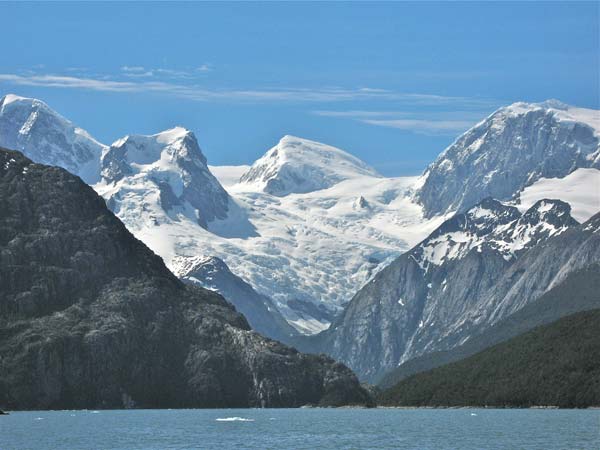
Glacial 'Armor' Can Help a Mountain Grow

Glaciers often behave as giant relentless bulldozers — rivers of ice that can level mountains and carve deep fjords over millennia.
Now, researchers unexpectedly reveal that glaciers can help mountains grow taller.
The well-known power that glaciers have to erode has been dubbed "the glacial buzz saw."
"It's been thought that glaciers limit the height of mountain ranges worldwide," said researcher Peter Reiners, a geochemist at the University of Arizona.
These findings, detailed in the Sept. 16 issue of the journal Nature, are the first to show that glaciers have a reverse effect on mountains in colder, high-latitude climates.
The researchers were surprised by what they found. "We were expecting to see the buzz saw," said researcher Stuart Thomson, a geologist at the University of Arizona.
Mountains primarily grow when movements of the Earth's crust push rock upward. It turns out that glaciers can also help growing mountains become taller by protecting them from erosion.
Sign up for the Live Science daily newsletter now
Get the world’s most fascinating discoveries delivered straight to your inbox.
The researchers discovered this effect, dubbed "glacial armoring," by investigating the Andes Mountains in the southernmost region of South America, known as Patagonia.
"It rains a lot in the Patagonian Andes, and when it's not raining, the sand flies come out," Reiners told Our Amazing Planet. "But it is an unbelievably beautiful and wild place, and just the raw texture of the land tells you that glaciers are incredibly important in shaping it."
The Andes are actively being pushed higher by movements of the Earth's crust.
"We're trying to understand how mountains are built and destroyed," Thomson said. "Why are mountains high?"
Wet and wild environment
To figure out how fast glaciers were eroding the Andes, over the last eight years, Thomson and his colleagues sailed up glacially cut fjords to the foot of remote glaciers and collected soccer-ball-size rocks exposed by erosion. In total, 146 samples were gathered across the length of the Patagonian Andes, from 38 degrees south latitude to 56 degrees south latitude, covering about 1,200 miles (2,000 kilometers).
"The most difficult aspect of this study is the sheer remoteness of most of the fjord region of southern Chile and working in some of the most hostile weather conditions in the world," Thomson said in an interview. "Parts of the region see more than 8 meters [26 feet] of rain per year, and the fjords are the first stop for the incessant storms of the Roaring Forties and Furious Fifties that batter this region."
"The one advantage is that the fjords and islands offer shelter from the worst storms and seas of the Pacific Ocean," Thomson said. "However, good sea-legs are a must. When the weather does abate, then the region does offer some of the most spectacular scenery including the largest tidewater glacier in the Southern Hemisphere outside Antarctica."
"We are not totally alone in the fjords," he added. "As well as the amazing wildlife, including whales, dolphins, seals, condors and albatross, we are often fortunate enough to encounter local centolla — southern king crab — fishermen. These guys stay out for months at a time in this remote region, and are always willing to share some of their catch with us, allowing for some of the best and freshest crab in the world."
In actively growing mountains, hot rocks from deep in the earth get thrust up. At the same time, erosion wears mountains down, bringing those rocks closer to the surface. The speed at which the rocks cool reveals how quickly the material above the rocks was removed by erosion — the slower the cooling, the more slowly the mountains are eroding and the higher they might grow.
The researchers used two independent dating methods, apatite uranium-thorium-helium dating and apatite fission-track dating, to determine how fast the rocks cooled. Both methods showed that the rocks cooled faster in the north and slower in the south.
"What corroborates this is that the mountains are higher in the south than in the north," Reiners said. "Uplift is winning in the south, and the glacial buzz saw is winning in the north."
Climate is key
The key factor behind glaciers eroding or protecting mountains is climate. Glaciers atop mountains in temperate latitudes flow downhill, scouring away mountain surfaces, grinding down the height and width of a mountain range by miles over the course of thousands of years. However, in very cold, high-latitude climates such as the Patagonian Andes, instead of scraping away mountain surfaces, the researchers discovered that glaciers get frozen to the bedrock, shielding the sides and tops of mountains from erosion.
"In the southern Patagonian Andes the mountains are up 1,000 meters [3,300 feet] higher than similar mountains in the more temperate parts of the Andes farther north," Thomson explained.
Below certain latitudes, "glacial buzzsaws clearly and efficiently operate, but south of about 45 degrees, it not only doesn't work, it has the opposite effect," Reiners said. "The glaciers actually protect the surface and allow the mountains to grow higher."
The researchers anticipate that glacial armoring also occurs on cold-climate mountains very far north, such as those in Alaska.
Thomson noted that many mineral- and oil-producing rocks are produced or destroyed as a result of glacial effects, and the development of better models to understand these processes "is vital to improving exploration of these resources."
- The World's Tallest Mountains
- In Images: Journey Into the Tropical Andes
- Image Gallery: Trekking to a Treacherous Glacier
This article was provided by OurAmazingPlanet, a sister site to LiveScience.











